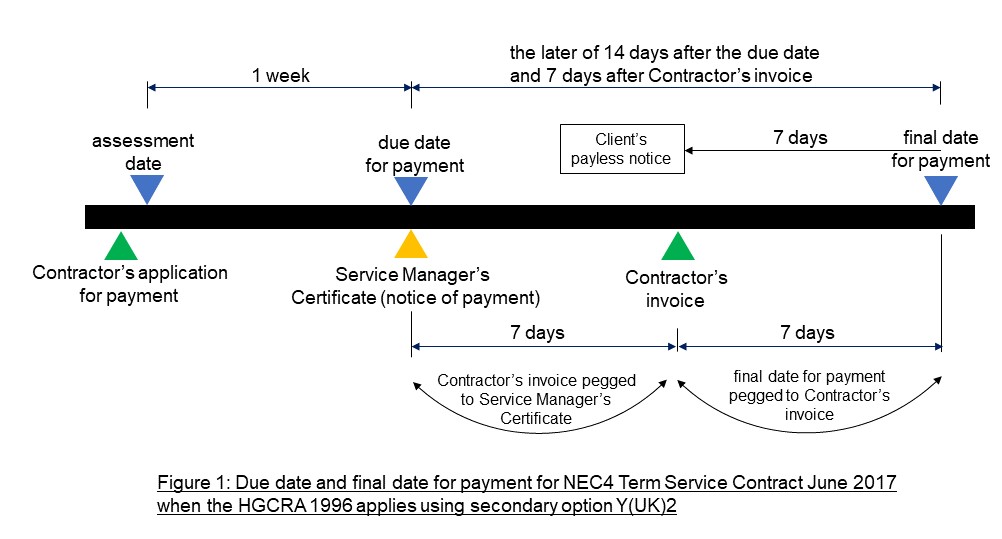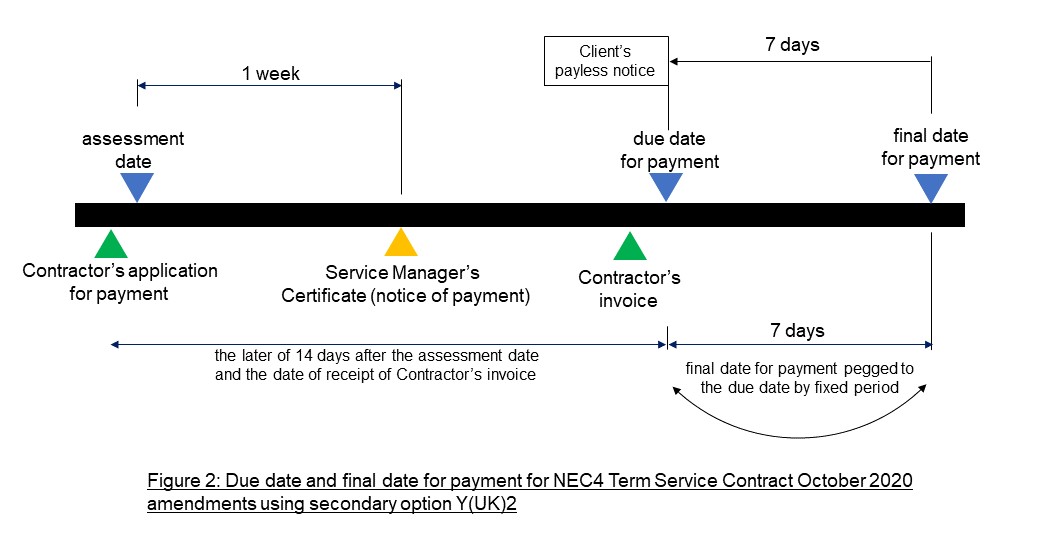In October 2020 a second set of amendments to the NEC4 June 2017 suite of contracts were published. Responding to the decision in Rochford v. Kilhan (2020)[1], the amendments include a change to the secondary option Y(UK)2 payment clause. In this article the author discusses the case and highlights the potential problem with the June 2017 payment regimes and explains the changes made to Y(UK)2 in the October 2020 amendments.
The case
A dispute arose over an application for payment made by Kilhan. As the subcontract works involved “construction operations” the Housing Grants Construction and Regeneration Act 1996 (the HGCRA) applied.
Kilhan had referred the matter to the adjudicator who concluded the subcontract did not comply with the payment provisions of the HGCRA and the Scheme for Construction Contracts 1998 (the Scheme) should apply. The adjudicator also decided Rochford had not complied with the Scheme as and as a result, the adjudicator decided that the payment claimed by Kilhan was owed by default.
Rochford asked the court to decide on new issues in connection with the due date and final date for payment and sought repayment of the sums previously paid to Kilhan.
The court dismissed Rochford’s arguments on the due date stating its case was “incorrect and unsustainable” due to the absence of a payment schedule referred to in the contract and uncertainty as to the date by which Kilhan were to make its application. Accordingly, the court decided the Scheme should apply and the due date for payment was the date of Kilhan’s application.
Regarding the final date for payment the court also held that the Scheme should apply. Citing Coulson LJ in Bennett v. CMC MBS[2], the court reaffirmed the purpose of the HGCRA is to achieve certainty and regular cash flow. The court criticised the subcontract’s payment provisions as “unworkable”. The problem again for Rochford was linkage to an absent payment schedule and uncertainty over a payment certificate which the subcontract required to be issued with an invoice.
Kilhan also presented a legal argument that s.110(1)(b) of the HGCRA requires the final date for payment to be linked to the due date by a fixed time period and not an event controlled by one of the parties e.g. payment notice or invoice. This being in direct contrast to s.110(1)(a) which requires “an adequate mechanism for determining what payments become due under the contract, and when.” Cockerill J agreed with Kilhan expressing the obiter view that, “the final date has to be pegged to the due date, and be a set period of time, and not an event or a mechanism.” Obiter views or obiter dicta (meaning by the way), do not form binding precedent but are considered by the courts as persuasive authority.
NEC4 June 2017 contracts
The NEC4 June 2017 edition of the Term Service Contract (TSC), Professional Service Contract (PSC) and Design Build and Operate Contract (DBOC) include payment mechanisms which link the final date for payment to submission of an invoice.
Secondary option Y(UK)2 is a payment clause for use when the HGCRA applies. Clause Y2.2 in the TSC4 includes the words:
The final date for payment is the later of
- fourteen days after the date on which payment becomes due, or a different period for payment if stated in the contract data and
- seven days after receipt by the party making the payment of an invoice, issued in accordance with these conditions of contract.
Y2.2 also states that the service manager’s certificate is the notice of payment.
Core clause 51.1 requires the payee to submit an invoice for the amount to be paid within one week of the service manager’s certificate. The final date for payment is therefore pegged to the submission of a valid invoice which is in turn is pegged to the notice of payment (see Figure 1).


If the service manager does not issue the payment certificate, the contractor’s application for payment becomes the payment notice (HGCRA s.110B(4)). However, if the contractor issues its invoice late or the invoice is invalid, this will extend the final date for payment. If the contractor does not submit its invoice the final date is never reached.
Making submission of a valid invoice a condition to payment is not unusual and it has been common practice for clients to amend the NEC forms to incorporate invoicing. This is principally to allow both the supplier and customer to comply with its obligations under VAT legislation. In the UK all VAT registered business are required to provide a VAT invoice to its customers on request. [3]
NEC4 October 2020 Y(UK)2 amendments
The amendments affect the TSC, PSC and DBOC. The new clause states:
The date on which a payment becomes due is the later of
- the date of receipt by the Party making payment of an invoice, issued in accordance with
these conditions of contract and
- fourteen days after the assessment date.
The contracts now uses submission of the contractor’s invoice to provide a mechanism for determining the payment due date. Core clause 51.1 has not been amended so the service manager is still required to issue its payment certificate within one week of the assessment date. The final date for payment is now pegged to the due date by a fixed period of 7 days unless a different period is stated in contract data part one. The 7 days between the due date and final date for payment ensures 21 day payment terms are maintained. However, Client’s should note this now means the latest date for serving a payless notice coincides with the due date for payment. (see Figure 2).


Conclusion and recommendations
If the obiter dicta of Cockerill J in Rochford v. Kilhan is correct, clients still using the June 2017 editions of the TSC4, PSC4 or DBOC4 should be mindful that where a valid invoice has not been submitted within 7 days of the payment certificate, the Scheme may apply resulting in an earlier date for both the final date for payment and the payless notice than that intended by the contract.
Whether the June 2017 or amended October 2020 version of Y(UK)2 is being used, to ensure the payment process provides certainty of payment and regular cash flow the parties should follow the contract ensuring that the
- contractor/consultant submits its application before the assessment date clearly setting out the amount it considers is due (50.2),
- service manager considers the payment application when assessing the amount due and issues a certificate within one week of the assessment date (50.2/51.1) and
- contractor submits its invoice within 7 days of the service manager’s certificate showing the amount due as stated on the certificate (51.1)
The parties should work together maintaining a diary of dates for the relevant applications, certificates and payments. For the reasons stated in Rochford v. Kilhan and other cases[4] it is not recommended a payment schedule is included in the contract.
Full details of all the October 2020 amendments are published on the NEC contact website.
Key points
- final date for payment should be linked to its due date by a fixed period of time
- VAT invoices are commonplace in construction contracts
- management of the payment process to ensure compliance with the contract and the HGCRA
David Hunter
16 November 2020
An edited version of this article was first published in the NEC User Group newsletter Issue No. 110 January 2021 (page 9) and can be downloaded here.
[1] Rochford Construction Ltd v Kilhan Construction Ltd [2020] EWHC 941 (TCC)
[2] Bennett (Construction) Ltd v CMC MBS Limited [2019] EWCA Civ 1515
[3] Value Added Tax (Amendment) (No 5) Regulations 2007
[4] For example: Balfour Beatty Regional Construction Ltd v Grove Developments Ltd v [2016] EWCA Civ 990



